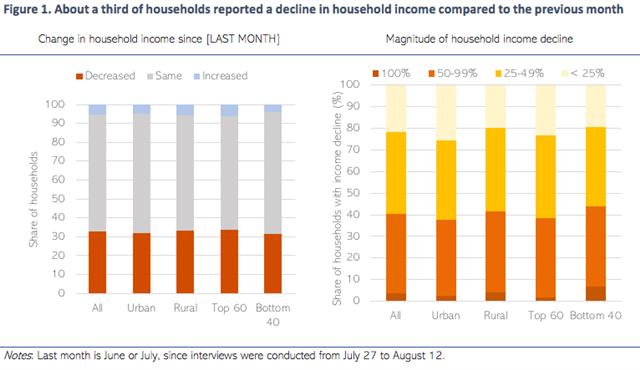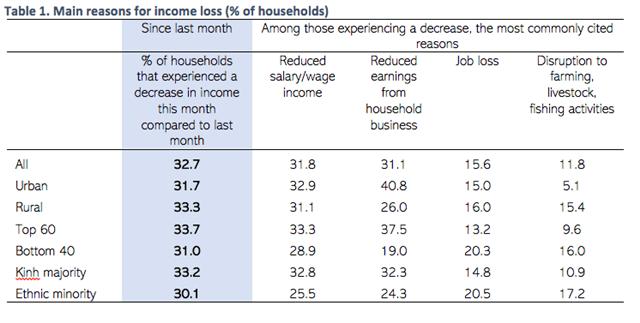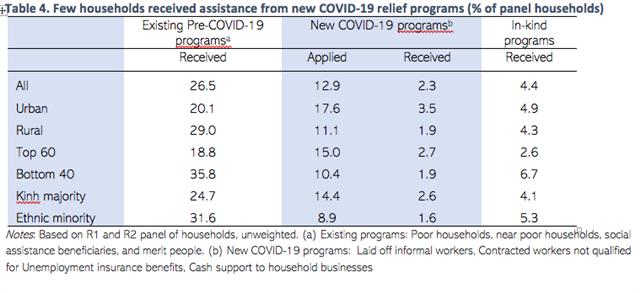Rate of Vietnam households reporting lower income narrows more than half: WB
Rate of Vietnam households reporting lower income narrows more than half: WB
About 13% of households in a panel of approximately 4,000 households had applied for at least one of three new Covid-19 relief programs since February, but only 2.3% of these households received any money by July/August.
A survey conducted by the World Bank with nearly 4,000 households nationwide from July 27 to August 12 – during which the second wave of Covid-19 infections hit, revealed 1/3 of the households reported a decline in income over the previous month, compared to 70% recorded in the first round of survey from February to June, suggesting signs of economic recovery.
Across the six regions of Vietnam, the decline in income ranged from 29% in the Midlands and Northern Mountainous areas to 38% in the Northern and Coastal Central region.

Source: World Bank
|
Some households are experiencing modest declines in household income. Among households who experienced a decline in income, about 40% reported their household income declining by at least 50% compared to the previous month. A small number (1.3% of all households) reported a complete loss of income.
Notably, those with family businesses were the most likely to report declining household income, while respondents working in agriculture or the public sector were the least likely.
Reasons cited for declines in household income reflect differences in economic activity across groups. For example, the top reason for income decline among urban households is reduced household business income. Rural households are three times as likely as urban households to cite farming disruptions as sources of income loss. Most households have a diversification of income sources.
Reduced farm and non-farm incomes are likely to affect the levels of input application – and could lead to a disruption in farming activities. Food price signals do not indicate that agriculture has been largely impacted.
Meanwhile, economic vulnerabilities do not appear to be significantly spreading to new households, but some households are experiencing prolonged economic hardships. Poor economic conditions are impacting some households consistently. About 4 out of 10 households who experienced income loss in Round 1 also saw continued income declines in Round 2. Among those that did not see their incomes decline in Round 1, only 17% reported a decrease in Round 2.

Source: World Bank.
|
Job loss remains a challenge
Among main respondents, job loss and job changes remain challenges. Job churning is still high, among respondents who were working, as many as 17% were working in a different job just one month ago. Reductions in wages and salaries was experienced by about 10% of total households.
The share of urban main respondents who were not working in Round 2 was slightly higher than in Round 1, 29.3% compared to 27.9% respectively. In Round 2, a higher share of urban respondents also reported they had stopped working recently.
Meanwhile, the vast majority of family businesses remain open, but a small share is struggling. Closures in family businesses also increased in Round 2 (reference period: June/July). Compared to results from Round 1 pertaining to May/June, the percentage of businesses that were operating in June/July declined from 95% to 90%.

Source: World Bank
|
Few households receive relief from gov’t support programs
By the end of July and mid-August, very few households reported receiving relief from the three new Covid-19 relief programs. About 13% of households in a panel of approximately 4,000 households had applied for at least one of three new Covid-19 programs since February, but only 2.3% of these households received any money by July/August. These rates are not substantially different than results from Round 1 since the government had discontinued the set of new Covid-19 relief programs at the end of July.
A much larger share of households was receiving benefits from pre-existing social assistance programs. However, negatively affected households during the pandemic were not necessarily the poorest who were already receiving social assistance, as is suggested by the larger share of urban households who applied to new Covid-19 programs.
A second outbreak in Danang and a continued economic slow-down are prolonging the negative economic effects of the pandemic borne by households.
The government estimates that job loss will likely continue through the end of the year. The Ministry of Labor, Invalids and Social Affairs (MOLISA) estimates 60,000-70,000 people will lose their jobs every month through the end of 2020.
Affected jobs are in services, tourism, construction, transport, and manufacturing sectors. The Vietnamese government has also estimated that over 31.8 million workers were negatively affected by the pandemic by September.



























